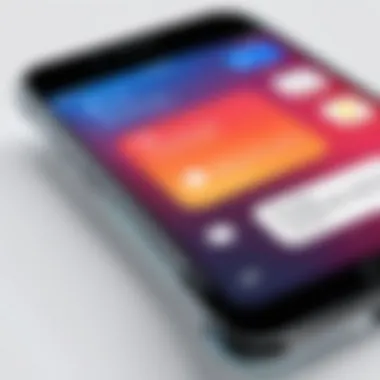iMessage for Android: Availability and Alternatives


Intro
In the fast-evolving world of messaging applications, iMessage stands out due to its robust features and tight integration with Apple's ecosystem. The question arises: how far does that integration extend outside of Apple devices? In recent years, Android users have expressed a strong interest in accessing iMessage functionalities. Yet, the question of whether an official iMessage app will become available for Android devices remains unanswered. This article explores several dimensions surrounding this topic, digging into current features, potential pathways for using iMessage on non-Apple devices, and viable alternatives available in 2021.
Key Features
iMessage Functionality and Unique Capabilities
iMessage presents several features that make it appealing to many users:
- End-to-end Encryption: Conversations on iMessage are known for their strong security, ensuring that messages are only visible to the sender and receiver.
- Rich Media Support: Users can send images, videos, and voice notes seamlessly, providing an interactive experience.
- Persistent Syncing Across Devices: Messages stay up-to-date across all Apple devices, allowing users to read and respond without losing context.
- Group Messaging: iMessage allows efficient group conversations, which can include multimedia sharing and reactions.
These features contribute significantly to the allure of iMessage, creating a sense of community among Apple’s user base. However, how does one experience this on an Android platform?
Current Availability and User Expectations
Despite persistent rumors, Apple has not released an Android version of iMessage. In 2021, there remains a lack of an official application or direct compatibility for Android users. This absence has prompted speculation about Apple’s strategy and future plans. As more users gravitate toward messaging apps, the demand for iMessage access on non-Apple devices could influence Apple's considerations.
"With the messaging landscape constantly shifting, user expectations are higher than ever for cross-platform solutions."
Alternatives to iMessage
Given the challenges in accessing iMessage on Android, users may explore various alternatives that offer similar functionalities. Popular choices include:
- WhatsApp: Known for its encryption and feature-rich environment, it has become a leading messaging app globally.
- Signal: Praised for privacy, this app focuses on secure communications without compromising user experience.
- Telegram: Offers numerous features like channels, bots, and large file-sharing potential.
While these platforms do not replicate iMessage completely, they provide valuable functionalities that might fulfill user needs.
Synthesis
As it stands in 2021, Android users seeking the unique capabilities of iMessage must navigate a landscape dominated by alternative messaging applications. Without official support from Apple, potential solutions like workarounds or using alternative apps are essential topics for ensuring communication remains robust and secure.
In summary, the interest in iMessage for Android persists among users, yet the reality diverges from the hope for native application availability. This exploration of remains essential for understanding the current state of messaging beyond Apple's closed ecosystem.
Preamble to iMessage
The topic of iMessage is significant, especially when discussing its potential for Android users. iMessage is not only a messaging application but a core part of Apple’s ecosystem that integrates seamlessly with iOS devices. Understanding iMessage means grasping its features, functionalities, and the overall experience it brings to its users. This article delves into whether iMessage will ever make its way to Android and the implications of such a development for the messaging landscape, particularly for those who desire cross-platform capabilities.
Understanding iMessage
iMessage is Apple’s proprietary instant messaging service, which allows users to send texts, photos, videos, and other multimedia content over the internet. Launched in 2011, it has become a hallmark of iPhone communication. It differentiates itself from conventional SMS messaging through its use of data rather than cellular service, which can result in faster delivery and lower costs for users. Key features of iMessage include end-to-end encryption, read receipts, and the ability to send messages from various Apple devices.
In addition to text messaging, iMessage supports a wide range of interactive features such as stickers, apps, and group chats. This rich functionality creates a more engaging experience. However, the exclusivity to Apple devices raises questions about accessibility for non-Apple users, which will be explored further in this article.
The Growth of Messaging Apps
The rise of messaging applications has transformed the way we communicate. As smartphones have proliferated globally, consumers have increasingly turned to mobile messaging apps for their convenience and versatility. Apps like WhatsApp, Telegram, and Signal have gained massive followings due to their ability to deliver real-time communication and unique features.
This shift highlights a growing demand for communication tools that can operate across different platforms. The desire for seamless communication has prompted many tech companies to innovate, while other brands have succumbed to competition. As we consider the future of messaging services, it is crucial to analyze the developments surrounding iMessage and how it stands in comparison to its competitors, particularly for the Android audience.


"The modern communication landscape is defined by user preferences for speed, security, and accessibility."
The implications of this growth in messaging apps lay the groundwork for understanding why a version of iMessage for Android could hold serious merit. As users look for ways to connect with friends and family on various platforms, any attempt by Apple to bridge this gap will be scrutinized and analyzed deeply throughout this article.
iMessage Compatibility with Android
The exploration of iMessage compatibility with Android is a critical topic in understanding the broader landscape of messaging applications. Apple’s iMessage has set a high standard for quality and functionality in messaging. Its unique features, such as end-to-end encryption, read receipts, and seamless integration with other Apple services, have made it a definitive tool for millions of users. However, the absence of an official iMessage application for Android limits access for a significant user base. Addressing compatibility issues is not only about the availability but also about ensuring a cohesive user experience between different platforms. This discussion brings to light how the divide between iOS and Android users affects communication and whether the future holds any promise for change.
Current Availability of iMessage on Android
As of 2021, there is no official version of iMessage available for Android users. Apple has not released any iMessage applications for devices running on the Android operating system. Users have expressed a strong desire for compatibility due to the increasing need for effective communication across platforms. The landscape remains unchanged since this is a strategic decision made by Apple, aiming to reinforce the engagement of its iOS user base. Many Android users, who might want to interact with family or friends using iMessage, are left with no direct options, limiting their ability to utilize these sought-after features.
"The lack of iMessage on Android creates a significant communication gap among users, particularly within families and friend groups."
Some people attempt workarounds, but these approaches often lead to frustration due to their complexity or limited functionality. For most, the impacts of this unsupported compatibility extend beyond technical issues; it also represents a social divide that can, at times, make interactions cumbersome.
Apple’s Stance on Third-Party Integration
Apple’s position regarding third-party integrations with iMessage has been distinctly conservative. The tech giant prioritizes user privacy and security, leading to a deliberate approach in how it manages its services. Although there are APIs available for developers to create messaging applications, they cannot tap into the full iMessage ecosystem. This stance has significant implications for developers seeking to incorporate iMessage-like functionalities into their applications. Many consumers are left wanting and questioning if a more open approach could yield an official iMessage for Android.
In essence, Apple appears focused on maintaining the exclusive nature of iMessage, which enriches the user experience for Apple device holders. Nonetheless, this exclusivity leaves Android users on the sidelines. The narrative increasingly raises questions about whether Apple may rethink its strategy in the future and consider the advantages of fostering cross-platform communication.
Potential for iMessage for Android
The potential for iMessage on Android stands at a complex intersection of user demand and technical feasibility. This topic is essential to understand as it sheds light on the future landscape of messaging applications. As mobile communication evolves, users increasingly seek seamless interactions across platforms. The inclusion of iMessage in the Android ecosystem could set a significant precedent in terms of convenience and functionality.
User Demand for Cross-Platform Messaging
The demand for cross-platform messaging has seen substantial growth in recent years. Users want to communicate effortlessly with friends and family, regardless of their device’s operating system. This desire transcends personal preference, as it reflects the need for connectivity in a diverse technological environment.
Several surveys indicate that a large segment of Android users either has family or friends using iPhones. They often express frustration at not being able to access iMessage features. Commonly sought features include group chat functionalities, read receipts, and the rich media sharing experience that iMessage offers.
Cross-platform messaging promotes both inclusivity and efficiency. A successful integration of iMessage into the Android platform could attract millions of users. Different messaging apps like WhatsApp and Telegram already benefit from this philosophy, allowing users from different operating systems to communicate. Thus, it seems plausible that Apple could reap similar rewards by tapping into the cross-platform market.
Technical Challenges in Development
While the demand exists, the technical challenges surrounding the development of iMessage for Android are noteworthy. Apple's ecosystem is known for its robust security measures and closed architecture. Opening iMessage to Android would require Apple to reconsider its existing protocols. The seamless transfer of messages across operating systems necessitates a more flexible architecture, which contradicts Apple’s long-standing practices.
Key challenges include:
- Security: Maintaining the integrity of users' conversations is paramount. Any loophole or weakness could lead to security breaches, undermining user trust.
- User Experience: To create an environment comparable to native iMessage experience, developers will need to ensure high-quality performance across different devices. Variability in Android hardware can present additional complications.
- Integration with Existing Services: iMessage interacts with other Apple services, such as FaceTime and Apple Pay. Adapting these functionalities for Android's landscape would require substantial development efforts and resources.
Despite these challenges, it is not impossible for Apple to consider a development path for iMessage on Android. However, the company would need to strategically address the above factors to ensure a successful rollout.
Alternatives to iMessage on Android
The discussion regarding alternatives to iMessage is significant in this article because many users seek options that can provide similar functionalities. The need for robust messaging applications increases as more people communicate across different platforms. Understanding the alternatives can help users make informed decisions while also considering various functionalities and user experiences.
Exploring Popular Messaging Apps


WhatsApp remains one of the most popular messaging apps globally. Its ease of use is a fundamental aspect that contributes to its widespread adoption. Users can send messages, voice notes, and make video calls without difficulty. The key characteristic of WhatsApp is its end-to-end encryption feature, ensuring that user communications are secure. This is especially important in today's environment where privacy concerns are prominent.
A unique feature of WhatsApp is its ability to create groups, allowing multiple users to communicate efficiently in one place. This functionality can be a significant advantage for family discussions or collaborative projects. However, one downside is that users must provide a phone number for registration, which some might view as a privacy risk.
Telegram
Telegram distinguishes itself with a focus on speed and security. Its cloud-based architecture makes it accessible across devices without consuming significant storage. The app's key characteristic is its support for large file sharing and unlimited group sizes, which are particularly attractive for those requiring extensive communication capabilities.
One notable feature is Telegram's channels, which allow for broadcasting messages to an unlimited number of subscribers. This can be beneficial for businesses or communities trying to reach a broader audience. However, some may find its interface less intuitive compared to competitors like WhatsApp, which can lead to a learning curve for new users.
Signal
Signal is celebrated for its privacy-first approach. It offers strong encryption, making it a standout choice for users determined to protect their information. The app includes features such as disappearing messages and extensive user customization options. The key characteristic of Signal is its commitment to security without sacrificing functionality.
A unique feature is its ability to hold secure video calls, which is increasingly important as remote interactions become more common. On the downside, since the app is less mainstream than competitors, some users might face challenges in finding their contacts who also use Signal, potentially limiting its utility.
Functionality Comparison
When comparing these three messaging apps, several key functionalities stand out:
- Security: All three apps offer varying levels of encryption, but Signal is often regarded as the gold standard for privacy.
- User Interface: WhatsApp has a straightforward design that appeals to many users. Telegram's interface may require time to learn, while Signal aims for simplicity but may feel less polished.
- Unique Features: WhatsApp excels with group functionalities, Telegram with its vast sharing capabilities, and Signal with its security features.
In summary, choosing an alternative to iMessage on Android involves considering individual needs regarding security, convenience, and functionality.
How to Use iMessage Features on Android
Understanding how to make use of iMessage features on Android devices is essential for users who value seamless communication across platforms. While iMessage remains exclusive to Apple devices, some users still seek ways to experience its functionalities on Android. The growing demand for interoperability in messaging platforms means a significant need for information on viable options.
Accessing iMessage Through Workarounds
Many Android users look for workarounds to access iMessage. These methods often include utilizing third-party applications or services that emulate iMessage functionality. Here are a few common paths:
- Remote Access Solutions: Some users employ remote desktop applications to access an Apple device running iMessage directly from their Android device. This means that both devices must be active, and a stable internet connection is required. Applications like TeamViewer or AnyDesk can provide this functionality.
- Emulator Software: Another approach is using emulator software that mimics iOS environments. However, this method often lacks reliability and may require substantial technical knowledge to set up effectively.
- Third-party Apps: Certain third-party applications claim to offer similar features to iMessage for Android users. These apps may create cloud-based messaging systems, allowing Android users to send and receive messages. However, the quality and safety of these applications can vary greatly.
It's essential to research thoroughly and verify the credibility of any solution before committing to it.
Potential Risks and Limitations
While some workarounds may provide limited functionality for accessing iMessage, they often come with risks and limitations. Here are key factors to consider:
- Security Concerns: Using remote desktop solutions or third-party applications may expose personal information to potential security vulnerabilities. Data privacy should always be a priority.
- Reliability: Many of these methods lack the reliability inherent to native applications. Connectivity issues can disrupt messaging capabilities, leading to missed communications.
- User Experience: Often, the experience varies vastly from the native iMessage platform. Features like read receipts, message effects, and integrated media sharing may not transfer properly.
To conclude, any attempts to access iMessage features on Android come with inherent challenges. Users should weigh the benefits against the potential risks carefully.
It is crucial to remain informed about security practices when using third-party applications for messaging.
In considering how to bridge the gap between iMessage and Android, users must navigate these complexities prudently.
Legal and Ethical Considerations
The exploration of iMessage's compatibility on Android goes beyond technical aspects, addressing legal and ethical considerations that affect its use. The legal landscape surrounding messaging apps is complex. It involves privacy concerns and copyright issues, both crucial for a comprehensive understanding of how iMessage features might operate on Android devices. Addressing these aspects not only protects users but also provides clarity on how information is handled and used.


Privacy Concerns with Messaging Apps
Privacy is a significant issue in today's digital messaging environment. As smartphone users rely on apps for communication, the need for protecting personal information is more vital than ever. Many messaging platforms, including iMessage, have full control over user data. This brings about questions regarding how this data is stored and used.
- Data Encryption: Messaging services often use encryption to protect conversations from unauthorized access. iMessage notably employs end-to-end encryption, meaning that only the sender and receiver can access the content of messages. This level of security is rare among many popular apps used today.
- User Data Collection: Apps like WhatsApp, Telegram, and Signal, each have distinct policies on data collection. It is important to analyze how extensively user data is collected and whether such data is leveraged for advertising or profiling.
- Potential Breaches: Cybersecurity is another crucial consideration. High-profile breaches can reveal sensitive information and lead to significant consequences for users. This raises the question of whether iMessage's infrastructure can withstand such attacks, especially if running on non-Apple devices.
The balance between user privacy and functionality is delicate. Users must weigh the benefits of using advanced messaging features against their privacy preferences.
Copyright Issues in Messaging Technologies
Another aspect that warrants discussion involves copyright issues relating to messaging technologies. As messaging applications evolve, so do the legal frameworks surrounding them. Different jurisdictions may have unique laws impacting how messaging apps operate:
- Software Licensing: If Apple were to create an iMessage platform for Android, it would need to navigate complex licensing agreements, not just for its own software but also for any third-party integrations.
- Content Ownership: Users frequently share media, texts, and other content in messaging fields. Who owns that content, and how can it be protected from misuse? This is a legal gray area. Companies must ensure users are informed about rights related to the content shared via their platforms.
- Intellectual Property: The integration of unique technologies and interfaces could give rise to potential patent disputes. If iMessage implements features that are similar to existing technologies on Android or other platforms, it may face legal challenges.
Overall, the legal and ethical landscape surrounding messaging applications is intricate. Awareness of these issues ensures users can choose platforms that respect their rights and adequately protect their information, while companies should work toward transparent practices in serving their users' needs.
"In the realm of digital communication, understanding legal ramifications is as vital as the technology itself."
Navigating these waters requires a careful approach, making informed decisions that prioritize both security and usability.
Future of Messaging Apps Post-2021
The future of messaging apps is a pivotal topic within the broader exploration of iMessage for Android. As technological advancements continue to shape the landscape of communication, understanding these developments is essential for users. The shift towards more integrated, secure, and responsive messaging tools is influenced by several factors, including market demand and emerging technologies.
The growing desire for seamless cross-platform communication has reshaped user expectations. People are no longer content with isolated ecosystems. They want to interact easily with others, regardless of their device preferences. Users increasingly expect features that allow for rich media sharing, enhanced privacy, and advanced functionalities in a user-friendly package.
This section will highlight two key areas: emerging trends in cross-platform messaging and the transformative impact of 5G on messaging services. Understanding these trends provides insights into the direction of messaging applications and their potential integration with platforms like iMessage.
Trends in Cross-Platform Messaging
Cross-platform messaging is becoming a standard rather than an exception. As users migrate between various devices, the need for platforms that allow frictionless communication is vital. Key trends include:
- Unified Messaging: Users prefer platforms that consolidate various messaging channels into a single interface, making it easier to communicate regardless of the application.
- Focus on Security: Privacy concerns have heightened demand for encryption and secure messaging options. Features like end-to-end encryption are becoming standard to protect user data.
- Smart Features Integration: Messaging apps are beginning to incorporate AI-driven features that enhance user experience. These can include chatbots for customer service, smart replies, and personalized content suggestions.
- Emphasis on Multimedia: As high-speed internet becomes more ubiquitous, apps are increasingly capable of supporting rich media sharing, including video calls and large file transfers.
Impact of 5G on Messaging Services
The introduction of 5G technology promises to revolutionize how messaging services operate. This has several significant implications:
- Increased Speed: 5G offers faster data transmission times, allowing messages, images, and videos to be sent almost instantaneously. This will enhance real-time communication, making it more engaging.
- Lower Latency: With reduced latency, the delay in message delivery significantly decreases. This will facilitate smoother interactions in group chats and during live conversations.
- Enhanced Capabilities: Applications will be able to support new features that require high bandwidth, such as HD video conferencing and augmented reality interactions built into messaging.
- Broadened Accessibility: With 5G networks expanding, more users will have access to high-speed internet. This inclusion supports the growth of various messaging platforms by reaching previously underserved demographics.
"As messaging apps evolve, they are increasingly shaping the landscape of digital communications, driven by user expectation and innovative technology."
As 2021 progresses and beyond, the outlook for messaging apps is robust. Those who stay informed about these changes will be better equipped to navigate the complexities of modern communication and will contribute to a richer user experience in messaging platforms, including anticipated developments related to iMessage for Android.
Finale
The conclusion serves as a crucial element in this examination of iMessage for Android. It encapsulates the primary insights gathered through the investigation, reinforcing the relevance of the topic in today's diverse messaging ecosystem. An effective conclusion will not only summarize the findings but also highlight the implications of these findings for users and developers alike.
Summary of Findings
Throughout this article, we have explored various facets of iMessage's accessibility for Android users. Key findings indicate that, as of now, iMessage remains exclusive to Apple's ecosystem, creating a significant gap for Android users wishing to experience its unique features. Our analysis shows a growing demand for cross-platform messaging solutions, which indicates a need for innovation in this area.
The discussion identified alternative messaging apps such as WhatsApp, Telegram, and Signal, which offer different functionalities but do not replicate the iMessage experience completely. Furthermore, potential workarounds for using iMessage on Android were examined, emphasizing the limitations and risks involved with these methods. Privacy and legal concerns regarding messaging platforms were also underscored as critical considerations in the evolving landscape of digital communication.
Final Thoughts on iMessage for Android
The future of iMessage for Android appears uncertain. While user demand for cross-platform functionality continues to rise, Apple has shown little inclination to provide a comprehensive solution for Android users. With trends favoring enhanced connectivity and the impact of technologies such as 5G, the messaging landscape may shift in unexpected ways.



